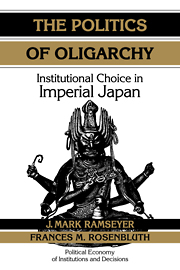Book contents
- Frontmatter
- Contents
- List of tables and figure
- Series editors' preface
- Acknowledgments
- CHAPTER 1 INTRODUCTION
- CHAPTER 2 THE COLLAPSE OF OLIGARCHY: FAILED ATTEMPTS AT CARTEL-MAINTENANCE
- CHAPTER 3 CONCESSION OR FACADE: THE MEIJI CONSTITUTION
- CHAPTER 4 ELECTORAL RULES AND PARTY COMPETITION: THE STRUGGLE FOR POLITICAL SURVIVAL
- CHAPTER 5 THE BUREAUCRACY: WHO RULED WHOM?
- CHAPTER 6 THE COURTS: WHO MONITORED WHOM?
- CHAPTER 7 THE MILITARY: MASTER OF ITS OWN FATE
- CHAPTER 8 FINANCIAL POLITICS
- CHAPTER 9 RAILROAD POLITICS
- CHAPTER 10 COTTON POLITICS
- CHAPTER 11 CONCLUSION: INSTITUTIONS AND POLITICAL CONTROL
- Notes
- References
- Index
CHAPTER 1 - INTRODUCTION
Published online by Cambridge University Press: 05 June 2012
- Frontmatter
- Contents
- List of tables and figure
- Series editors' preface
- Acknowledgments
- CHAPTER 1 INTRODUCTION
- CHAPTER 2 THE COLLAPSE OF OLIGARCHY: FAILED ATTEMPTS AT CARTEL-MAINTENANCE
- CHAPTER 3 CONCESSION OR FACADE: THE MEIJI CONSTITUTION
- CHAPTER 4 ELECTORAL RULES AND PARTY COMPETITION: THE STRUGGLE FOR POLITICAL SURVIVAL
- CHAPTER 5 THE BUREAUCRACY: WHO RULED WHOM?
- CHAPTER 6 THE COURTS: WHO MONITORED WHOM?
- CHAPTER 7 THE MILITARY: MASTER OF ITS OWN FATE
- CHAPTER 8 FINANCIAL POLITICS
- CHAPTER 9 RAILROAD POLITICS
- CHAPTER 10 COTTON POLITICS
- CHAPTER 11 CONCLUSION: INSTITUTIONS AND POLITICAL CONTROL
- Notes
- References
- Index
Summary
BACKGROUND
During the last three decades of the nineteenth century and the first four of the twentieth, basic political control in Japan shifted twice. In the 1910s it shifted from a handful of oligarchs to a larger group of professional politicians. In the 1930s it shifted again, this time to a set of independent military leaders.
In this book we explore those shifts. We ask why the oligarchs failed to design institutions that protected their power, why the elected politicians did no better, and what political and economic consequences the various institutions had. More generally, we ask whether the shifts may explain some of the dynamics of oligarchic government and clarify some of the theoretical aspects of the relationship between institutional structure and regime change.
The puzzle
In explaining political control in Imperial Japan, most scholars implicitly posit three hypotheses. In their concern for authenticity and precision, they seldom state them as baldly as we do here. We admit that we strip their accounts of much of the richness and nuance that they give them. Although we do this reluctantly, we do it intentionally – for what we lose in subtlety we capture in clarity. Richness and sophistication can confuse as well as contextualize, and we simplify the discussion here because we think the simplicity clarifies the essential logic at stake.
First, most scholars argue that the oligarchs who controlled the government in the late nineteenth century largely (not exclusively) tried to promote the national interest.
- Type
- Chapter
- Information
- The Politics of OligarchyInstitutional Choice in Imperial Japan, pp. 1 - 14Publisher: Cambridge University PressPrint publication year: 1995



